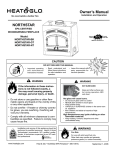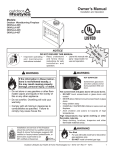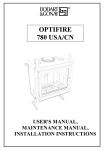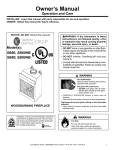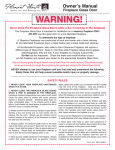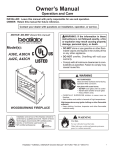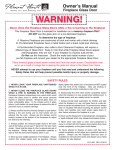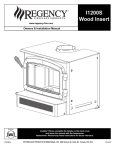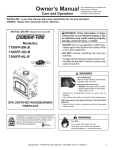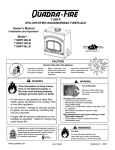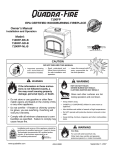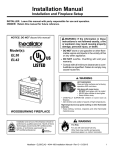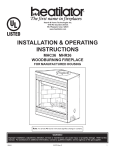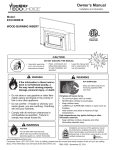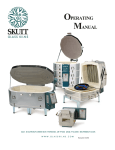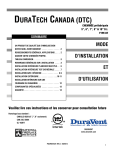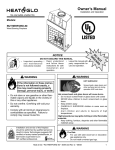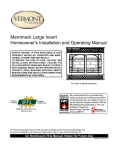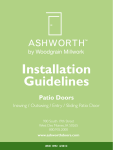Download 4044-187E EL36-42 Owners Manual 7-14-14.indd
Transcript
Owner’s Manual Operation and Care INSTALLER: Leave this manual with party responsible for use and operation. OWNER: Retain this manual for future reference. Contact your dealer with questions on installation, operation, or service. NOTICE: DO NOT discard this manual! Model(s): WARNING: If the information in these instructions is not followed exactly, a fire or explosion may result causing property damage, personal injury, or death. • DO NOTstoreorusegasolineorotherflammablevaporsandliquidsinthevicinityofthis oranyotherappliance. • DO NOT overfire. Overfiring will void your warranty. • Complywithallminimumclearancestocombustiblesasspecified.Failuretocomplymay causehousefire. EL36 EL42 WARNING HOT SURFACES! Glassandothersurfacesarehotduring operationANDcooldown. Hot glass will cause burns. • DO NOTtouchglassuntilitiscooled • NEVERallowchildrentotouchglass • Keepchildrenaway • CAREFULLY SUPERVISE children in same room as fireplace. • Alertchildrenandadultstohazardsofhightemperatures. WOODBURNING FIREPLACE Installationandserviceofthisfireplaceshouldbe performedbyqualifiedpersonnel.Hearth&Home TechnologiesrecommendsNFIcertifiedprofessionals,ortechnicianssupervisedbyan NFIcertifiedprofessional. High temperatures may ignite clothing or other flammable materials. • Keep clothing, furniture, draperies and other flammable materialsaway. WARNING Fire Risk. For use with solid wood fuel only. Other fuels may overfire and generate poisonous gases (i.e. carbon monoxide). Heatilator•EL36/EL42OwnerManual•4044-187•RevE•07/14/14 1 Safety Alert Key: DANGER! Indicates a hazardous situation which, if not avoided will result in death or serious injury. WARNING! Indicates a hazardous situation which, if not avoided could result in death or serious injury. CAUTION! Indicates a hazardous situation which, if not avoided, could result in minor or moderate injury. NOTICE: Indicates practices which may cause damage to the fireplace or to property. • • • • Table of Contents 4 Maintenance and Service 1Welcome A. Congratulations B. LIMITED LIFETIME WARRANTY 3 4 2 Product Specific and General Information A. Appliance Certification 6 B. Vented Gas Log Sets, Gas Inserts, Gas Log Lighters and Wood-burning Inserts 6 3 Important Safety and Operating Information A. Fireplace Safety 1. Clear Space 2. Grate 3. Refractory 4. Firescreen 5. Flue Damper 6. Glass Doors 7. Over-Firing Your Fireplace 8. Chimney Fire B. General Operating Parts 1. Flue Damper 2. Outside Air (optional) 3. Glass Doors C.Fuel 1. Hardwood vs. Softwood 2. Moisture content 3. Seasoning 4. Storing Wood 5. Burning Process 6. Creosote Formation 7. Processed Solid Fuel Firelogs D.First Fire E. Lighting Instructions 2 7 7 8 8 8 8 8 8 8 9 10 10 10 11 11 11 12 12 12 12 12 12 13 A. Chimney Inspection B. Creosote (Chimney) Cleaning C.Grate D.Glass Cleaning E. Ash Removal F. Refractory/Firebrick 5Troubleshooting A. FAQs 6 Reference Materials ► A. Service Parts B. Accessories C.Contact Information Heatilator • EL36/EL42 Owner Manual • 4044-187 • Rev E • 07/14/14 14 15 16 16 16 16 18 20 22 24 1 Welcome A.Congratulations Read this manual before installing or operating this fireplace. Please retain this owner’s manual for future references. Congratulations on selecting a Heatilator wood burning fireplace. The Heatilator fireplace you have selected is designed to provide the utmost in safety and reliability. This Owner's Manual should be retained for future reference. We suggest that you keep it with your other important documents and product manuals. As the owner of a new fireplace, you'll want to read and carefully follow all of the instructions contained in this Owner's Manual. Pay special attention to all Cautions and Warnings. Your new Heatilator wood burning fireplace will give you years of durable use and trouble-free enjoyment. Welcome to the Heatilator family of fireplace products! Heatilator is a registered trademark of Hearth & Home Technologies. Local Dealer Information Dealer: Fill in your name, address, phone and e-mail information here and fireplace information below. Dealer Name: ________________________________________________________ Address: ____________________________________________________________ ____________________________________________________________ Phone: _____________________________________________________________ E-mail: _____________________________________________________________ Fireplace Information: Brand:_________________________________________________ Model Name:____________________________ Serial Number:___________________________________________ Date Installed:___________________________ Listing Label Information/Location The model information regarding your specific fireplace can be found on the rating plate usually located in the control area of the fireplace. Serial Number Fireplace Model Grate FIREPLACE NO. WARNING: RISK OF FIRE DAMAGE. REPLACE GRATE WITH HEARTH & HOME TECHNOLOGIES MODEL NO. MODEL NO. MFG. DATE FIRECHAMBER INTENDED FOR USE WITH HEARTH & HOME TECHNOLOGIES LISTED FIREPLACE PARTS. SEE INSTALLATION AND OPERATING INSTRUCTIONS FOR THIS MODEL. ONLY HEARTH & HOME TECHNOLOGIES GLASS DOOR KITS CAN BE INSTALLED ON THIS UNIT. FIREPLACE ALSO FOR USE IN MANUFACTURED HOMES FAN KIT MODEL NO. YES CLEARANCE TO COMBUSTIBLES: NO & DO NOT OVERFIRE. USE ONLY: SOLID WOOD FUEL OR LISTED DECORATIVE GAS APPLIANCE. DO NOT USE A FIREPLACE INSERT OR OTHER PRODUCTS NOT SPECIFIED FOR USE WITH THIS PRODUCT. IF DOORS ARE USED OPERATE FIREPLACE WITH DOORS FULLY OPEN OR CLOSED ONLY. WHEN BURNING A DECORATIVE GAS APPLIANCE IN THE FIREPLACE, ADJUST DAMPER TO THE FULLY OPEN POSITION. CHIMNEY 2 IN. MIN. RATED AT 115 VOLTS, 50/60 Hz., IN. MIN. FIREBOX AMP. WARNING! THIS FIREPLACE HAS NOT BEEN TESTED WITH AN UNVENTED GAS LOG SET. TO REDUCE THE RISK OF FIRE OR INJURY, DO NOT INSTALL AN UNVENTED GAS LOG SET INTO FIREPLACE. WARNING! THIS APPLIANCE IS NOT FOR USE AS COOKING EQUIPMENT. IF INSTALLATION OR OPERATING INSTRUCTIONS ARE MISSING CONTACT: HEARTH & HOME TECHNOLOGIES., 7571 - 215th Street West, Lakeville, MN 55044. Heatilator • EL36/EL42 Owner Manual • 4044-187 • Rev E • 07/14/14 3 B.LIMITED LIFETIME WARRANTY Hearth & Home Technologies LIMITED LIFETIME WARRANTY Hearth&HomeTechnologies,onbehalfofitshearthbrands(”HHT”),extendsthefollowingwarrantyforHHT gas,wood,pellet,coalandelectrichearthappliancesthatarepurchasedfromanHHTauthorizeddealer. WARRANTY COVERAGE: HHTwarrantstotheoriginalowneroftheHHTapplianceatthesiteofinstallation,andtoanytransfereetakingownership oftheapplianceatthesiteofinstallationwithintwoyearsfollowingthedateoforiginalpurchase,thattheHHTappliance willbefreefromdefectsinmaterialsandworkmanshipatthetimeofmanufacture.Afterinstallation,ifcoveredcomponentsmanufacturedbyHHTarefoundtobedefectiveinmaterialsorworkmanshipduringtheapplicablewarrantyperiod, HHTwill,atitsoption,repairorreplacethecoveredcomponents.HHT,atitsowndiscretion,mayfullydischargeallofits obligationsundersuchwarrantiesbyreplacingtheproductitselforrefundingtheverifiedpurchasepriceoftheproduct itself.Themaximumamountrecoverableunderthiswarrantyislimitedtothepurchasepriceoftheproduct.Thiswarranty issubjecttoconditions,exclusionsandlimitationsasdescribedbelow. WARRANTY PERIOD: Warrantycoveragebeginsonthedateoforiginalpurchase.Inthecaseofnewhomeconstruction,warrantycoverage beginsonthedateoffirstoccupancyofthedwellingorsixmonthsafterthesaleoftheproductbyanindependent, authorizedHHTdealer/distributor,whicheveroccursearlier.Thewarrantyshallcommencenolaterthan24months followingthedateofproductshipmentfromHHT,regardlessoftheinstallationoroccupancydate.Thewarrantyperiodfor partsandlaborforcoveredcomponentsisproducedinthefollowingtable. Theterm“LimitedLifetime”inthetablebelowisdefinedas:20yearsfromthebeginningdateofwarrantycoveragefor gasappliances,and10yearsfromthebeginningdateofwarrantycoverageforwood,pellet,andcoalappliances.These timeperiodsreflecttheminimumexpectedusefullivesofthedesignatedcomponentsundernormaloperatingconditions. WarrantyPeriod Parts Labor 1Year 2years HHTManufacturedAppliancesandVenting Gas X X Wood X X X 3years Pellet EPA Wood Coal X X X X X X X X X ComponentsCovered Electric Venting X X Allpartsandmaterialexceptas coveredbyConditions, Exclusions,andLimitations listed Igniters,electroniccomponents, and glass Factory-installedblowers Moldedrefractorypanels X Firepotsandburnpots 5years 1year 7years 3years 10 years 1year X Limited 3years Lifetime X X X X X 90Days X X X X X X X X Castingsandbaffles X X Manifoldtubes, HHTchimneyandtermination Burners,logsandrefractory Fireboxandheatexchanger X X Allreplacementparts beyondwarrantyperiod Seeconditions,exclusions,andlimitationsonnextpage. 4021-645F02-18-13 4 Page1of2 Heatilator • EL36/EL42 Owner Manual • 4044-187 • Rev E • 07/14/14 WARRANTY CONDITIONS: • ThiswarrantyonlycoversHHTappliancesthatarepurchasedthroughanHHTauthorizeddealerordistributor.Alistof HHTauthorizeddealersisavailableontheHHTbrandedwebsites. • ThiswarrantyisonlyvalidwhiletheHHTapplianceremainsatthesiteoforiginalinstallation. •ThiswarrantyisonlyvalidinthecountryinwhichtheHHTauthorizeddealerordistributorthatsoldtheappliance resides. • Contactyourinstallingdealerforwarrantyservice.Iftheinstallingdealerisunabletoprovidenecessaryparts,contact thenearestHHTauthorizeddealerorsupplier.Additionalservicefeesmayapplyifyouareseekingwarrantyservice fromadealerotherthanthedealerfromwhomyouoriginallypurchasedtheproduct. • Checkwithyourdealerinadvanceforanycoststoyouwhenarrangingawarrantycall.Travelandshippingcharges forpartsarenotcoveredbythiswarranty. WARRANTY EXCLUSIONS: Thiswarrantydoesnotcoverthefollowing: • Changesinsurfacefinishesasaresultofnormaluse.Asaheatingappliance,somechangesincolorofinteriorand exteriorsurfacefinishesmayoccur.Thisisnotaflawandisnotcoveredunderwarranty. • Damagetoprinted,plated,orenameledsurfacescausedbyfingerprints,accidents,misuse,scratches,melteditems, orotherexternalsourcesandresiduesleftontheplatedsurfacesfromtheuseofabrasivecleanersorpolishes. • Repairorreplacementofpartsthataresubjecttonormalwearandtearduringthewarrantyperiod.Theseparts include:paint,wood,pelletandcoalgaskets,firebricks,grates,flameguides,batteriesandthediscolorationofglass. • Minorexpansion,contraction,ormovementofcertainpartscausingnoise.Theseconditionsarenormalandcomplaintsrelatedtothisnoisearenotcoveredbythiswarranty. • Damagesresultingfrom:(1)failuretoinstall,operate,ormaintaintheapplianceinaccordancewiththeinstallation instructions,operatinginstructions,andlistingagentidentificationlabelfurnishedwiththeappliance;(2)failureto installtheapplianceinaccordancewithlocalbuildingcodes;(3)shippingorimproperhandling;(4)improperoperation,abuse,misuse,continuedoperationwithdamaged,corrodedorfailedcomponents,accident,orimproperly/ incorrectlyperformedrepairs;(5)environmentalconditions,inadequateventilation,negativepressure,ordrafting causedbytightlysealedconstructions,insufficientmake-upairsupply,orhandlingdevicessuchasexhaustfansor forcedairfurnacesorothersuchcauses;(6)useoffuelsotherthanthosespecifiedintheoperatinginstructions;(7) installationoruseofcomponentsnotsuppliedwiththeapplianceoranyothercomponentsnotexpresslyauthorized andapprovedbyHHT;(8)modificationoftheappliancenotexpresslyauthorizedandapprovedbyHHTinwriting; and/or(9)interruptionsorfluctuationsofelectricalpowersupplytotheappliance. • Non-HHTventingcomponents,hearthcomponentsorotheraccessoriesusedinconjunctionwiththeappliance. • Anypartofapre-existingfireplacesysteminwhichaninsertoradecorativegasapplianceisinstalled. • HHT’sobligationunderthiswarrantydoesnotextendtotheappliance’scapabilitytoheatthedesiredspace.Informationisprovidedtoassisttheconsumerandthedealerinselectingtheproperappliancefortheapplication.Considerationmustbegiventoappliancelocationandconfiguration,environmentalconditions,insulationandairtightnessof thestructure. This warranty is void if: • • • Theappliancehasbeenover-firedoroperatedinatmospherescontaminatedbychlorine,fluorine,orotherdamaging chemicals.Over-firingcanbeidentifiedby,butnotlimitedto,warpedplatesortubes,rustcoloredcastiron,bubbling, crackinganddiscolorationofsteelorenamelfinishes. Theapplianceissubjectedtoprolongedperiodsofdampnessorcondensation. Thereisanydamagetotheapplianceorothercomponentsduetowaterorweatherdamagewhichistheresultof,but notlimitedto,improperchimneyorventinginstallation. LIMITATIONS OF LIABILITY: • Theowner’sexclusiveremedyandHHT’ssoleobligationunderthiswarranty,underanyotherwarranty,expressor implied,orincontract,tortorotherwise,shallbelimitedtoreplacement,repair,orrefund,asspecifiedabove.Inno eventwillHHTbeliableforanyincidentalorconsequentialdamagescausedbydefectsintheappliance.Somestates donotallowexclusionsorlimitationofincidentalorconsequentialdamages,sotheselimitationsmaynotapplytoyou. Thiswarrantygivesyouspecificrights;youmayalsohaveotherrights,whichvaryfromstatetostate.EXCEPTTO THEEXTENTPROVIDEDBYLAW,HHTMAKESNOEXPRESSWARRANTIESOTHERTHANTHEWARRANTY SPECIFIEDHEREIN.THEDURATIONOFANYIMPLIEDWARRANTYISLIMITEDTODURATIONOFTHE EXPRESSEDWARRANTYSPECIFIEDABOVE. 4021-645F02-18-13 Page2of2 Heatilator • EL36/EL42 Owner Manual • 4044-187 • Rev E • 07/14/14 5 2 Product Specific and General Information A.Appliance Certification This fireplace system has been tested and listed in accordance with UL 127 and ULC-S610 standards by Underwriters Laboratories Inc. for installation and operation in the United States and Canada. This fireplace may be installed in sleeping rooms EXCEPT in manufactured homes. If installed with a gas log set, provisions for the National Fuel Gas Code must be met. This fireplace has been tested and listed for use with the optional components specified in this manual. These optional components may be purchased separately and installed at a later date. An outside air kit, gas log set, gas insert or gas log-lighter should be installed at the time of fireplace installation. B.Vented Gas Log Sets, Gas Inserts, Gas Log Lighters and Wood-burning Inserts • Optional • Vented gas log sets, gas inserts, gas log-lighters or wood-burning inserts can be installed in this fireplace. Follow the instructions provided with the accessory for operation. Warning! Risk of Fire or Asphyxiation! • DO NOT install unvented gas logs. • Damper must be locked open. • Gas flame may generate fumes. Heatilator is a registered trademark of Hearth & Home Technologies. Warning! Risk of Fire! For use with solid wood fuel only. Other fuels may overfire and generate poisonous gases (i.e. carbon monoxide). 6 Heatilator • EL36/EL42 Owner Manual • 4044-187 • Rev E • 07/14/14 3 Important Safety and Operating Information A. Fireplace Safety 1. Clear Space Mostproblemsarecausedbyimproperinstallationandoperationofthefireplace.Toprovidereasonablefiresafety, thefollowingshouldbegivenseriousconsideration: • Thefireshouldbesupervisedwheneverthefireplaceis inuse. • An annual inspection should be performed on the fireplacesystem. • Installatleastonesmokedetectoroneachfloorofyour hometoensureyoursafety. • InstallaconvenientlylocatedClassAfireextinguisher nearthefireplace. • Deviseapracticedevacuationplan,consistingofatleast twoescaperoutes. • Deviseaplantodealwithachimneyfire: - Evacuate. - Notifythefiredepartment. WARNING! Risk of Fire! Hearth & Home Technologies disclaims any responsibility for, and the warranty and agencylistingwillbevoidedbythefollowingactions. DO NOT: • operatedamagedfireplace • modifyfireplace • overfire • installanyunventedgaslogset • installanycomponentnotapprovedbyHearth&Home Technologies • installpartsorcomponentsnotListedorapproved • operate the fireplace without fully assembling all components Combustiblematerialsmustnotbestoredonthehearth extension.Roomfurnishingssuchasdrapes,curtains, chairs or other combustibles must be at least 4ft (1219mm)fromthefrontofthefireplace. Combustible materials are materials made of or surfacedwithanyofthefollowingmaterials: - - - - Wood - Compressedpaper Plantfibers - Plastic Plywood/OSB - Drywall Anymaterialthatcanigniteandburn,flameproofed ornot,plasteredorun-plastered. Non-combustiblematerialsarematerialswhichwillnot igniteandburn,composedofanycombinationofthe following: - - - - Steel Brick Concrete Glass - - - - Iron Tile Slate Plasters WARNING! Risk of Fire! Keep combustible materials, gasolineandotherflammablevaporsandliquidsclearof thefireplace. DO NOT: • storeflammablematerialsclosetothefireplace • use gasoline, lantern fuel, kerosene, charcoal lighter fluidorsimilarliquidstostartor“freshenup”afireinthis fireplace. Improper installation, adjustment, alteration, service or maintenancecancauseinjuryorpropertydamage. 40-1/2 in. (1029 mm) Clear space bottom of fireplace to lower edge of mantel or trim 48 in. (1219 mm) Clear Space Front of Fireplace Figure 3.1 12 in. (305 mm) Clear Space Sides of Fireplace (from the FP opening) Clear Space Heatilator•EL36/EL42OwnerManual•4044-187•RevE•07/14/14 7 2.Grate 7. Over-Firing Your Fireplace This fireplace is designed to be used with the supplied grate or one approved by HHT. Warning! Risk of Fire! Use only the factory-supplied integral grate. • Keeps logs in place. • Allows proper air circulation around the fire. 3.Refractory The refractory is supplied to contain heat and provide an attractive interior. It will break down over time and will need occasional replacement. Small hairline cracks and discoloration are normal and do not affect its safety. Warning! Risk of Fire! Do not burn fireplace without refractory. Use only refractory supplied by Hearth & Home Technologies. 4.Firescreen The firescreen is provided to control sparks. Keep it closed when the fireplace in use. Warning! Risk of Fire or Burns! • Screen will not prevent burning materials from falling out. • Screen pulls or handles may be hot. 5. Flue Damper The flue damper must be in the fully opened position during operation of the fireplace. Warning! Risk of Fire and Asphyxiation! Open damper prior to operating fireplace. A closed damper overfires the fireplace and spills smoke and flames into the room. WARNING! Risk of Fire! Do not over-fire. Over-firing may ignite creosote or will damage the fireplace and chimney. To prevent over-firing your fireplace. DO NOT: • use flammable liquids • overload with wood • burn trash or large amounts of scrap lumber • permit too much air to the fire Symptoms of over-firing may include one or more of the following: • • • • • chimney connector or fireplace glowing roaring, rumbling noises loud cracking or banging sounds metal warping chimney fire 8. Chimney Fire In the event of a chimney fire • Have the chimney and adjacent structure inspected by qualified professionals. Hearth & Home Technologies recommends that NFI or CSIA certified professionals, or technicians under the direction of certified professionals, conduct a minimum of an NFPA 211 Level 2 inspection of the chimney. • Replace components of the chimney and fireplace as specified by the professionals. • Ensure all joints are properly engaged and the chimney is properly secured. Warning! Risk of Fire! A chimney fire can permanently damage your chimney system. Failure to replace damaged components and make proper repairs can cause a structure fire. 6. Glass Doors Glass doors are optional. Warning! Risk of Fire! Install ONLY doors approved by Hearth & Home Technologies. Warning! Risk of Fire and Smoke! Fireplace equipped with doors should be operated only with doors fully open or doors fully closed. If doors are left partly open, gas and flame may be drawn out of the fireplace opening. 8 Heatilator • EL36/EL42 Owner Manual • 4044-187 • Rev E • 07/14/14 WARNING HOT SURFACES! GlassandothersurfacesarehotduringoperationANDcooldown. Hot glass will cause burns. • DO NOTtouchglassuntilitiscooled • NEVERallowchildrentotouchglass • Keepchildrenaway • CAREFULLYSUPERVISEchildreninsameroomasfireplace. • Alertchildrenandadultstohazardsofhightemperatures. High temperatures may ignite clothing or other flammable materials. • Keepclothing,furniture,draperiesandotherflammablematerialsaway. CAUTION! Ifyouexpectthatchildrenmaycomeintocontactwiththisfireplace,werecommendabarriersuchasadecorative screen.Seeyourdealerforsuggestions. B. General Operating Parts WARNING! DO NOT operatefireplacebeforereadingandunderstandingoperatinginstructions.Failuretooperatefireplaceaccordingtooperatinginstructionscouldcausefireorinjury. Close Open Close Open Outside Air Control Handle Figure 3.2 Flue Damper General Operating Parts Heatilator•EL36/EL42OwnerManual•4044-187•RevE•07/14/14 9 1. Flue Damper 3. Glass Doors RefertoFigure3.2forlocationandoperationofcontrol. Before lighting the fireplace, verify fully open position bylookingupfromtheinsideofthefireplace. • Glassdoorsareoptional. • RefertoFigure2.2forhowtoproperlyusethem. 2. Outside Air (optional) FULLY OPEN CORRECT PARTLY OPEN INCORRECT FULLY CLOSED CORRECT PARTLY CLOSED INCORRECT The outside air kit supplies some combustion air for yourfireplace.Itmayhelpreducetheeffectsofnegativeairpressure. • RefertoFigure3.2forlocationofcontrol • Close the inlet to prevent cold drafts when the fireplaceisnotbeingused. CAUTION! Risk of Burns! The outside air control handleisHOTwhenfireplaceisinoperation.Adjust BEFORElightingfire. Figure 3.4 10 Operating Positions of Bi-fold Doors Heatilator•EL36/EL42OwnerManual•4044-187•RevE•07/14/14 C.Fuel Warning! For use with solid wood fuel only. Other fuels may overfire and generate poisonous gases (i.e. carbon monoxide). 1. Hardwood vs. Softwood Your fireplace’s performance depends on the quality of the firewood you use. One species of wood varies very little to the other in terms of energy content. All seasoned wood contains about 8,000 BTU’s per pound. Hardwoods have a greater density than softwoods; a piece of hardwood will contain about 60% more BTU’s than an equal size piece of softwood. A cord of seasoned oak (hardwood) would contain about 60% more potential energy than a cord of seasoned pine (softwood). Most softwoods are coniferous. These are trees with needle-like leaves that stay green all year and carry their seeds exposed in a cone. Examples of coniferous trees are Douglas fir, pine, spruce and cedar. Softwoods, being more porous, require less time to dry, burn faster and are easier to ignite than hardwoods. Hardwoods are deciduous trees, broadleaf trees that lose their leaves in the fall. Their seeds are usually found within a protective pod or enclosure. Some examples of deciduous trees are oak, maple, apple, and birch. However, it should be noted that there are some deciduous trees that are definitely not considered hardwoods such as poplar, aspen and alder. Hardwoods require more time to season, burn slower and are usually harder to ignite than softwoods. Obviously, you will use the type of wood that is most readily available in your area. However, if at all possible the best arrangement is to have a mix of softwood and hardwood. This way you can use the softwood for starting the fire, giving off quick heat to bring the fireplace up to operating temperature. Add the hardwood for slow, even heat and longer burn time. Soft woods Hard woods • • • • • • • • • • • Douglas Fir Pine Spruce Cedar Poplar Aspen Alder Warning! Risk of Fire! • Do NOT burn wet or green wood. • Wet, unseasoned wood can cause accumulation of creosote. 2. Moisture content The majority of the problems fireplace owners experience are caused by trying to burn wet, unseasoned wood. Freshly cut wood can be as much water as it is wood, having a moisture content of around 50%. Imagine a wooden bucket that weighs about 8 pounds. Fill it with a gallon of water, put it in the firebox and try to burn it. This sounds ridiculous but that is exactly what you are doing if you burn unseasoned wood. Dead wood lying on the forest floor should be considered wet, and requires full seasoning time. Standing dead wood can be considered to be about two-thirds seasoned, if cut at the dry time of the year. Burning wet, unseasoned wood will produce less heat output because it requires energy in the form of heat to evaporate the water trapped inside. This is wasted energy that should be used for heating your home. This moisture evaporates in the form of steam which has a cooling effect in your firebox and chimney system. When combined with tar and other organic vapors from burning wood it will form creosote which condenses in the relatively cool firebox and chimney. Even dry wood contains at least 15% moisture by weight, and should be burned hot enough to keep the chimney hot for as long as it takes to dry the wood out - about one hour. To tell if wood is dry enough to burn, check the ends of the logs. If there are cracks radiating in all directions from the center, it is dry. If your wood sizzles in the fire, even though the surface is dry, it may not be fully cured. Oak Maple Apple Birch Heatilator • EL36/EL42 Owner Manual • 4044-187 • Rev E • 07/14/14 11 5. Burning Process 3.Seasoning Seasoned firewood is nothing more than wood that is cut to size, split and air dried to a moisture content of around 20%. The time it takes to season wood varies from around nine months for soft woods to as long as eighteen months for hardwoods. The key to seasoning wood is to be sure it has been split, exposing the wet interior and increasing the surface area of each piece. A tree that was cut down a year ago and not split is likely to have almost as high a moisture content now as it did when it was cut. To season wood: • • • Cut logs to size Split to 6 in. (152 mm) or less Air dry to a moisture content of around 20% - Soft wood - about nine months - Hard wood - about eighteen months Notice: Seasoning time may vary depending on drying conditions. 6. Creosote Formation When wood is burned slowly, it produces tar and other organic vapors which combine with expelled moisture to form creosote. The creosote vapors condense in the relatively cool chimney flue of a newly-started or a slow-burning fire. As a result, creosote residue accumulates on the flue lining. When ignited, creosote creates an extremely hot fire which may damage the chimney or even destroy the house. The chimney shall be inspected at least annually before lighting, or once every two months during heating season. When creosote has accumulated it shall be removed to reduce the risk of a chimney fire. 4. Storing Wood Splitting wood before it is stored reduces drying time. The following guideline will ensure properly seasoned wood: • Stack the wood to allow air to circulate freely around and through the woodpile. • Elevate the woodpile off the ground to allow air circulation underneath. • The smaller the pieces, the faster the drying process. Any piece over 6 in. (152 mm) in diameter should be split. • Wood should be stacked so that both ends of each piece are exposed to air, since more drying occurs through the cut ends than the sides. This is true even with wood that has been split. • Store wood under cover, such as in a shed, or covered with a tarp, plastic, tar paper, sheets of scrap plywood, etc., as uncovered wood can absorb water from rain or snow, delaying the seasoning process. Avoid covering the sides and ends completely. Doing so may trap moisture from the ground and impede air circulation. 12 Fire requires fuel, air and heat. If heat is robbed from the fireplace during the drying stage, the new load of wood has reduced the chances for a good clean burn. Always burn dry, seasoned firewood. 7. Processed Solid Fuel Firelogs Manufactured firelogs may be used with this fireplace. Hearth & Home Technologies recommends the use of UL Classified processed fuel firelogs. Follow the manufacturer’s lighting and safety instructions. Using firelogs may require more frequent chimney inspections and cleaning. Do not poke or stir the logs while they are burning. Use only firelogs that have been evaluated for the application in manufactured fireplaces and refer to firelog warnings and caution markings on packaging prior to use. D.First Fire Before lighting your first fire in the fireplace, make certain that: • refractory is in place • all labels have been removed Heatilator • EL36/EL42 Owner Manual • 4044-187 • Rev E • 07/14/14 E. Lighting Instructions Notice: You must establish a good draft to prevent smoke spillage into the room. The first three or four fires should be of moderate size to allow the oils and binders to be burned from the fireplace and the refractory and paint to cure. You may notice an industrial odor the first few fires. This is considered normal. Use well-seasoned wood. • Open the flue damper to a fully open position. • Place crumpled or twisted paper under the fireplace grate. • Loosely arrange kindling or small pieces of wood to form a ‘tent’ on the fireplace grate. • Pre-warm the flue to establish a draft to help reduce smoke spillage during start-up. Hold a rolled up piece of burning newspaper under the flue damper for a few moments. • Light the crumpled paper to ignite the kindling. • Add small pieces of wood until a hot bed of embers has been established. • Add a minimum of three average size pieces of split firewood, placed to allow combustion air and flames between them. Warning! Risk of Fire! Keep combustible materials, gasoline and other flammable vapors and liquids clear of the fireplace. Do NOT: • store flammable materials close to the fireplace • use gasoline, lantern fuel, kerosene, charcoal lighter fluid or similar liquids to start or “freshen up” a fire in this fireplace. Heatilator • EL36/EL42 Owner Manual • 4044-187 • Rev E • 07/14/14 13 4 Maintenance and Service Warning! Hot Surfaces! Glass and other surfaces are hot during operation AND cool down. DO NOT clean fireplace until it is cooled. ► WARNING! Risk of Asphyxiation and Fire! Annual inspection by qualified technician recommended. Check: • condition of doors, surrounds and fronts • condition of glass and glass assembly • obstructions of combustion and ventilation air • obstructions of termination cap Clean: • glass • air passageways, grilles A.Chimney Inspection Frequency: As necessary; at least annually before lighting fireplace, or once every two months during heating season. By: Homeowner/Chimney Sweep • Confirm that termination cap remains clear and unobstructed. • Inspect for blockages such as bird nests, leaves, etc. • Inspect for corrosion or separation. • Inspect for creosote and remove as needed, at least every two months during the heating season. • Inspect the system at the fireplace connection and at the chimney top. In the event of a chimney fire, Hearth & Home Technologies recommends replacement of the chimney and inspection of the adjacent structure to the provisions of NFPA Level III inspection criteria. 14 Heatilator • EL36/EL42 Owner Manual • 4044-187 • Rev E • 07/14/14 B.Creosote (Chimney) Cleaning Frequency: As needed; at least annually before lighting, or once every two months during heating season. When creosote has accumulated it shall be removed to reduce the risk of a chimney fire. By: Chimney Sweep Tools Needed: Brush, Phillips screwdriver • When wood is burned slowly, it produces tar and other organic vapors, which combine with expelled moisture to form creosote. The creosote vapors condense in the relatively cool chimney flue of a slow-burning fire. As a result, creosote residue accumulates on the flue lining. When ignited, this creosote makes an extremely hot fire. • Remove all ash from the firebox and extinguish all hot embers before disposal. Allow the fireplace to cool completely. • Close the door tightly. • Remove the top of the termination cap as shown in Figure 4.1 to clean the cap and chimney. • The creosote or soot should be removed from the chimney with a brush specifically designed for the size of chimney in use. • Reinstall termination cap. • Clean out fallen debris from the firebox. Warning! Risk of Fire! Ignited creosote is extremely HOT. Prevent creosote buildup. Remove screws, lift top cover. 1. Remove the 4 screws. 2. Remove the screen. 3. Remove the baffle. Remove 4 screws and lift top pan off. Top Cover Cap Top Top Cap Cap Chimney Slip Section TR344/TR342 Round Termination Cap Remove 8 screws and lift top. Remove 2 screws from the front and back and lift the top off. Screw Screw Chase ST375 Square Termination Cap TS345/TS345P Square Termination Caps TCT375 Terra Cotta Termination Cap DTO/DTS Series Termination Cap Figure 4.1 Chimney & Termination Cap Cleaning Heatilator • EL36/EL42 Owner Manual • 4044-187 • Rev E • 07/14/14 15 C.Grate Frequency: After each ash removal By: Homeowner Inspect grate for: • Warping or sagging 1-1/2 in. (38 mm) or more • Broken welds • Burn-through of grate bars For safe operation, replace only with the approved grate from Hearth & Homes Technologies. D.Glass Cleaning Frequency: As necessary By: Homeowner Tools Needed: Vinegar or glass cleaner, soft towel • Clean glass with a non-abrasive glass cleaner. Use a damp cloth dipped in wood ashes or a commercially available oven cleaner. Remove any oven cleaner residue with a glass cleaner or soap and water. E. Ash Removal Frequency: As necessary By: Homeowner Tools Needed: Covered metal container, metal shovel, fireplace broom Warning! Risk of Fire! Do not remove ashes until the fire is out and the fireplace is cold. • Ashes should be placed in metal container with tight fitting lid. • The closed container of ashes should be placed on a noncombustible floor or on the ground, well away from all combustible materials, pending final disposal. • If the ashes are disposed of by burial in soil or otherwise locally dispersed, they should be retained in the closed container until all cinders have thoroughly cooled. F.Refractory/Firebrick Frequency: By: Tools Needed: • Inspect condition of brick. Replace if crumbly or otherwise deteriorated, or if cracks exceed 1/4 in. (6 mm). 16 Heatilator • EL36/EL42 Owner Manual • 4044-187 • Rev E • 07/14/14 5 Troubleshooting Start Fire Problems Possible Cause Solution Can’t get fire started Excessive smoke or spillage Burns too slowly Smolders, sizzles Not enough kindling/paper or no kindling/paper Use dry kindling, more paper. Arrange kindling & wood for air movement. Damper closed/not fully open Open damper. Not enough air for fire to ignite Check for restricted cap/shroud. Open air kit (if installed). Check for flue blockage. Pre-warm flue before starting fire (refer to starting fire section). Check for adequate vent height (refer to chimney assembly section). Open window below the fireplace towards the wind. Wood condition is too wet, too large Use dry, seasoned wood (refer to wood fuel section). Bed of coals not established before adding wood Start with paper & kindling to establish bed of coals (refer to starting fire section). Flue blockage such as birds’ nests or leaves in termination cap Have chimney inspected for creosote and cleaned by a certified chimney sweep. Down draft or negative pressure Competition with exhaust devices Do not use exhaust fans during start-up (refer to negative pressure section). Open window below the fireplace towards the wind. Fire burns too fast Extremely dry or soft wood Mix in hardwood. Mix in less seasoned wood after fire is established (refer to wood fuel section). No glass doors Add glass doors to slow down air flow. Overdrafting Check for correct vent height; too much vertical height creates overdrafting. Check location of vent termination (refer to chimney assembly section). Heatilator • EL36/EL42 Owner Manual • 4044-187 • Rev E • 07/14/14 17 A.FAQs Hearth & Home Technologies assumes no responsibility for the improper performance of the fireplace system caused by inadequate draft due to environmental conditions, down drafts, tight sealing construction of the structure, or mechanical exhausting devices which will create a negative air pressure within the structure where the fireplace is located. If smoke spillage occurs from a fireplace opening when the door is open, there is either a leakage in the flue, a blockage in the flue, or some condition is affecting draft Understanding and differentiating the conditions which can cause each of these kinds of spillage problems is essential to their solution. • Flue Leakage Check for improperly connected flue joints or a damaged flue joint in the chimney system. Such leakage would reduce draft (air would be drawn in through the leaks rather than through the fireplace). The result might be difficult start-up and smoky fires that might spill if other adverse draft conditions accompany this problem. • Flue Blockage The damper should be open. Check for objects that may have fallen down the chimney. Flue draft is measured as negative pressure in the chimney. The amount of negative pressure determines how strong the draft is. The draft is important because it draws the combustion air into the fireplace and pulls the smoke out of the chimney. There are three basic criteria essential in establishing and maintaining flue draft: • availability of combustion air • heat generated from the fire • diameter and height of the flue system These three factors work together as a system to create the flue draft. Increasing or decreasing any one of them will affect the other two and thus change the amount of draft in the entire system. If the fire is hard to start and smoke spills out of the fireplace, or you find it difficult to establish and maintain a moderately high burn rate, then the flue draft is too low and corrective measures must be taken. erating instructions, “Starting a Fire”. Be sure your flue system is installed correctly and that it is the proper diameter and height. Check for the following: • All chimney sections are properly installed. • The chimney is clean and free of creosote or soot buildup. • Make sure overhanging trees and branches are cut back within ten feet of the top of the chimney and the chimney is free of debris from animals. • Ensure the chimney cap is clean and free of any buildup of soot or creosote if cap is equipped with a spark arrestor screen. • The wood being used in dry and well seasoned. If you still suspect you have a low draft problem it may be necessary to increase the volume of air in your flue system. Since the diameter of your flue system is matched with the size of the flue collar and should not be changed, then the height of the system must be increased. Add chimney sections one at a time until the draft improves. In some cases, regardless of what you do, it can still be difficult to establish the proper flue draft. This is especially evident when using an exterior factory-built chimney or exterior masonry chimney. Try holding a burning rolled up newspaper as close to the flue outlet as possible for a few minutes, then light the paper under the kindling. The heat generated from the burning rolled up newspaper should help get the draft established. Still other factors can affect how well your flue system performs. Neighboring structures, high winds, tall trees, even hillsides can affect air currents around the chimney. Well designed chimney caps are available that can help. Your fireplace dealer is the local expert in your area. He can usually make suggestions or discover problems that can be easily corrected allowing your fireplace to operate correctly as it has been designed, providing safe and economical heat for your home. Contact your dealer for additional information regarding operation and troubleshooting. Visit www.heatilator.com to find a dealer. Be sure you have air available for combustion and that your firewood is dry and well seasoned. Build your fires properly and according to the instructions given in op- 18 Heatilator • EL36/EL42 Owner Manual • 4044-187 • Rev E • 07/14/14 nd ina y term chimne n? tio Bird's nest or leaves in termination cap? ds ar ou Overhanging tree? in gw Stron Structural changes in chimney area? Another appliance in home also exhausting air (furnace, fan, Unsealed dryer, etc.)? can lights? Overhead fan operating? Creosote buildup in flue? Air register from furnace near fireplace? Doors opening and closing? Window closed for start-up? Figure 5.1 Combustion air control Outside air closed? Factory-built Fireplaces: Troubleshooting Heatilator•EL36/EL42OwnerManual•4044-187•RevE•07/14/14 19 20 16 17 18 Part number list on following page. 15 14 13 12 19 20 11 10 (Air Handle) 9 8 21 7 2- Damper Kit Element Woodburning Fireplace Service Parts EL36 1Piece Rod 2 Piece Rod 6 22 5 4 3 1 07/14 23 Beginning Manufacturing Date: Jan 2005 Ending Manufacturing Date: Active DamperBladeAssembly DamperControl 5 6 Grate GrateRetainer HearthRetainer HearthRefractory FirescreenAssembly 17 18 19 20 21 23 11866B 31527 Qty2req 4044-188 4044-187 InstallationManual Owner’sManual 18320 4044-116 Qty2req SmokeBaffle Qty2req 4044-161 Qty4req NailingFlange StripProtector 101025/24 Pkgof24 4044-165 4025-023 4044-179 4044-175 2Piece(Qty2req) 10002 4044-028 4044-129 4044-128 4044-170 GR41 4044-130 4044-114 11847 4044-131 1piece Qty2req Qty2req Qty2req Qty3req 4044-104 CUST4017-001 15425 4044-143 4044-124 Overlay 4044-124 Not Replaceable Must Oder 4044-111 12460/40 Qty4req Pkgof40 4044-152 4044-030 28900 19785A 4044-029 22069B PART NUMBER HairPinClip SmokeShieldKitInstallationInstructions FastenerPack ExtendedSmokeShieldKit DoorPivotClip FirescreenRod FirescreenHandle BackRefractory SmokeShield 13 16 DoorTrack(usedforupper) SideRefractory RightSideColumn 11 12 15 BottomFrontFace 10 RefractoryRetainer LeftSideColumn 9 14 TopFrontFace 8 **Screws TopStandoff 7 22 COMMENTS **Ifdamperrodisinplaceandneedsthedamperbladeorderdamper weight(19785A),screws(12460/40)&damperblade(11835) DamperRod 4 **DamperWeight DamperKitRepair 3 StarterSectionAssembly 2 DESCRIPTION 1 ITEM Y Y Y Y Y Y Y Stocked at Depot EL36 Beginning Manufacturing Date: Jan 2005 Ending Manufacturing Date: Active IMPORTANT:THISISDATEDINFORMATION.Partsmustbeorderedfromadealerordistributor. Hearth and Home Technologies does not sell directly to consumers.Providemodel numberandserialnumberwhenrequestingservicepartsfromyourdealerordistributor. Service Parts Reference Materials ► A.Service Parts 6 Heatilator • EL36/EL42 Owner Manual • 4044-187 • Rev E • 07/14/14 Heatilator • EL36/EL42 Owner Manual • 4044-187 • Rev E • 07/14/14 21 16 17 18 Part number list on following page. 15 13 14 12 19 20 11 10 (Air Handle) 9 8 21 7 2- Damper Kit Element Woodburning Fireplace Service Parts EL42 1Piece Rod 2 Piece Rod 6 07/14 6 5 22 DamperBladeAssembly HearthRetainer 19 23 4044-143 4044-105 4044-104 Must Oder Overlay CUST4017-001 12052 2Piece(Qty2req) 4044-187 Owner’sManual 101025/24 4044-188 Pkgof24 InstallationManual HairPinClip 18320 4044-116 StripProtector 4044-161 Qty2req SmokeBaffle 4044-165 Qty4req NailingFlange 4025-023 SmokeShieldKitInstallationInstructions 4044-180 31527 4044-172 1piece Qty2req 10002 4044-027 4044-112 4044-109 4044-170 GR40 4044-113 4044-114 11847 4044-120 1ea Qty2req Qty2req Qty2req Qty3req 4044-105 Not Replaceable 15427 4044-111 12460/40 4044-152 4044-030 28900 19785A 4044-029 Qty4req Pkgof40 PART NUMBER 22069B FastenerPack ExtendedSmokeShieldKit DoorPivotClip FirescreenRod FirescreenHandle FirescreenAssembly GrateRetainer 18 21 Grate 17 HearthRefractory BackRefractory 16 20 SideRefractory 15 DoorTrack(usedforupper) 12 RefractoryRetainer RightSideColumn 11 14 BottomFrontFace 10 SmokeShield LeftSideColumn 9 13 TopFrontFace 8 **Screws TopStandoff 7 22 COMMENTS Y Y Y Y Y Y Y Stocked at Depot EL42 Beginning Manufacturing Date: Jan 2005 Ending Manufacturing Date: Active **Ifdamperrodisinplaceandneedsthedamperbladeorderdamper weight(19785A),screws(12460/40)&damperblade(11835) DamperControl DamperRod 5 **DamperWeight 3 DamperKitRepair 2 DESCRIPTION StarterSectionAssembly 1 ITEM 4 23 Service Parts IMPORTANT:THISISDATEDINFORMATION.Partsmustbeorderedfromadealerordistributor. Hearth and Home Technologies does not sell directly to consumers.Providemodel numberandserialnumberwhenrequestingservicepartsfromyourdealerordistributor. 4 3 1 Beginning Manufacturing Date: Jan 2005 Ending Manufacturing Date: Active B.Accessories Doors DM1036 with Black, Polished Brass or Stainless Steel Trim DM1042 with Black, Polished Brass or Stainless Steel Trim Gas Inserts Gas Log Sets Gas Log Lighters Wood-burning Inserts 22 Heatilator • EL36/EL42 Owner Manual • 4044-187 • Rev E • 07/14/14 This page intentionally left blank. Heatilator • EL36/EL42 Owner Manual • 4044-187 • Rev E • 07/14/14 23 C.Contact Information Heatilator, a brand of Hearth & Home Technologies 7571 215th Street West, Lakeville, MN 55044 www.heatilator.com Please contact your Heatilator dealer with any questions or concerns. For the number of your nearest Heatilator dealer, please visit www.heatilator.com. – NOTES – CAUTION DO NOT DISCARD THIS MANUAL • Important operating and maintenance instructions included. • Read, understand and follow these instructions for safe installation and operation. • Leave this manual with party responsible for use and operation. This product may be covered by one or more of the following patents: (United States) 5000162, 5016609, 5076254, 5113843, 5191877, 5218953, 5263471, 5328356, 5341794, 5347983, 5413089, 5429495, 5452708, 5542407, 5890485, 5931661, 5941237, 5947112, 5996575, 6006743, 6019099, 6048195, 6053165, 6145502, 6170481, 6237588, 6296474, 6374822, 6413079, 6439226, 6484712, 6543698, 6550687, 6601579, 6672860, 6688302, 6688302B2, 6715724B2, 6729551, 6736133, 6748940, 6748942, 6769426, 6774802, 6796302, 6840261, 6848441, 6863064, 6866205, 6869278, 6875012, 6880275, 6908039, 6919884,7047962, 7216645, D320652, D445174, D462436; (Canada) 1297749, 2195264, 2225408, 2313972; (Australia) 780250, 780403, 1418504 or other U.S. and foreign patents pending. Printed in U.S.A. - Copyright 2012 24 Heatilator • EL36/EL42 Owner Manual • 4044-187 • Rev E • 07/14/14
























